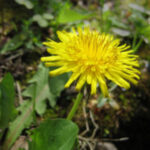Lovage is a celery-like vegetable that can be planted from seed in the spring or fall and produces leaves and stalks that are edible in just a few months.
The leaves can be cooked in soups, stews, and any dish requiring herbal flavor or used fresh in salads to complement lettuce. Young tender lovage leaves can also replace basil to make an excellent, economical pesto! The lovage stalks are crunchy when fresh and can be used like fresh celery for salads, crudités and hors d’oeuvres. The stalks can also be sautéed or boiled just like celery to make sauces, soups and stews.
Unlike celery or basil or other leafy green vegetables and some herbs, lovage is a perennial that grows fast, requires minimal care, and re-seeds itself year after year in ever-expanding numbers of plants. Its scent and flavor are powerfully celery-like, yet mild enough to chop up and eat fresh or use as a garnish like parsley.
Lovage can be started with an inexpensive package of seeds, but it is not a common seed found in local nurseries or stores that stock seeds. Several online companies and seed catalogue mailers carry lovage seeds, so they are easily ordered.
Lovage grows to a height of approximately three feet in about three months and can be continually cut and trimmed during the growing season as it re-sprouts growth all summer.Lovage seeds will drop and self-plant in the plot over the years, but can also blow and sprout beyond their area and need to be pulled or mowed to contain them.
Lovage plants are extremely hardy and can survive harsh winters with below zero temperatures. They die back to the ground or can be trimmed to the ground in fall, but re-sprout in early spring.
Plants can also be easily transplanted at almost any stage of growth and acclimate quickly to a new plot. The lovage plant does prefer full sunlight for best growth.
Very few insects attack this plant, and while you may see neighboring plants full of bug holes from nibbling pests, the lovage leaves will remain almost completely resistant to insects and other nuisance nibblers such as rabbits.
Since you will have massive quantities of lovage in just the first year of growth from one packed of seeds, it’s good to know that this plant is easily preserved in a number of different ways, so you can have a yearlong supply every year. The lovage leaves are easily dried in the sun on screens or in the house in a food dehydrator. Once dried, the leaves can be put in jars in bits or pulverized to a powder with a mortar and pestle. A fast way to preserve lovage is simply to cut leaves and stalks and put them in plastic bags and store them as is in the freezer. Whenever you need a flavorful addition to a cooked dish, you can chop up the lovage and toss it in the pot – leaves, stalks, and all!
You can also make quantities of pesto and freeze it in containers – but don’t add the cheese until you’re ready to use it. A simple pesto recipe is: mash two cups of lovage leaves (the younger the better) with a mortar and pestle into a paste, add six to eight garlic cloves (depending on how much you like garlic!) and mash until creamy, then add about a quarter cup of chopped nuts (of course, pine nuts are the classic standard, but they can be extremely expensive, so you can use other nuts such as walnuts or almonds), and then finally stream in about a quarter cup of olive oil, stirring until the pesto reaches a rich, thick paste. This paste can be frozen in ice cube trays and transferred to plastic baggies, or large quantities can be frozen in tubs. To use as a classic pesto sauce over fettuccini, let the paste defrost at room temperature and then add grated parmesan cheese to taste (one quarter to one full cup), a half-teaspoon salt and fresh ground black pepper. You can also use this paste without adding the cheese to make a great salad dressing or vegetable dip by adding vinegar or mayonnaise to create a consistency that you like. You can also add frozen pesto cubes to soups and stews to add a terrific garlicky-celery taste.
That lovage flavor can also be preserved in vinegars. Simple stuff a sterilized quart jar with fresh-picked lovage leaves, fill the jar with white wine vinegar, cap the jar with a metal lid using a paper coffee filter between the jar and lid to prevent the metal from reacting with the vinegar, and store in a cool, dark cupboard for approximately three weeks, shaking periodically. Strain out all the leaves and you will have a beautiful green vinegar that you can refrigerate and use for up to three months to flavor dressings or use like a wine in sautéing vegetables, meats, and poultry. You can also pour the liquid into a fancy bottle with a cork, add a sprig of tarragon, and have a chef’s gourmet vinegar that can be displayed as an attractive part of a kitchen’s décor or table setting.
Lovage – a versatile plant you’ll love to have in your garden forever!
The Perennial Food Garden Series highlights fruits, vegetables, and herbs that are easily grown, mature rapidly, are prolific in production, versatile in recipes, and return year after year. The series highlights the top perennials to create a perfect food garden that is economical to start and easy to maintain.



